 Do you want to create a strong social media content strategy?
Do you want to create a strong social media content strategy?
Are you looking for tools to help you analyze the content on your competitors' social media profiles?
To create a content strategy that engages and motivates your audience, you need to do a comprehensive social media audit.
In this article I'll share how to perform a social media audit to build a successful social media content strategy.
#1: Identify Your Competitors
Most businesses have already identified the main players in their industry by searching Google or social networks.
If you don't already have a list of competitors at hand, just search for your site on SEMrush to see a list of related providers. SEMrush automatically sorts them by competition level based on how many common keywords the sites rank for in Google.
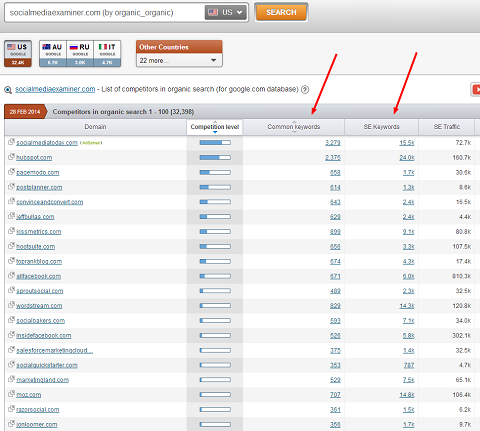
Once you've identified some potential competitors, the next step is to check out whether they're active on social media. Simply visit their websites and search for social media icons, then visit those profiles. If they're posting actively across social channels, add them to your list of competitors.
For this example, we'll use Social Media Today and HubSpot as our target competitors, comparing them to Social Media Examiner‘s social presence.
#2: Establish Your Baselines
An inexpensive and powerful tool for social audits is TrueSocialMetrics.
To do a social audit, you'll need to sign up for a small or medium account. A small account will allow you to track your site plus two competitors; with the medium account, you can track your site and up to nine competitors.
Start by adding your own site:
- Click on Settings on the top right.
- Click on Account.
- Create a new account.
- Click on Connect Twitter. Here, you'll be asked to authorize app. Log into your own Twitter account and give TrueSocialMetrics access to Twitter's API. Then enter your Twitter profile.
Follow the same steps for Facebook, Google+ and all of the other networks that you'd like to track.
Next, follow the steps on TrueSocialMetrics to create an account and add your competitors.
Get World-Class Marketing Training — All Year Long!
Are you facing doubt, uncertainty, or overwhelm? The Social Media Marketing Society can help.
Each month, you’ll receive training from trusted marketing experts, covering everything from AI to organic social marketing. When you join, you’ll also get immediate access to:
- A library of 100+ marketing trainings
- A community of like-minded marketers
- Monthly online community meetups
- Relevant news and trends updates
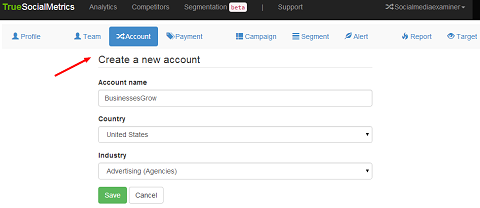
Click on Metric for an overview of the account's social activity for a predetermined time period.
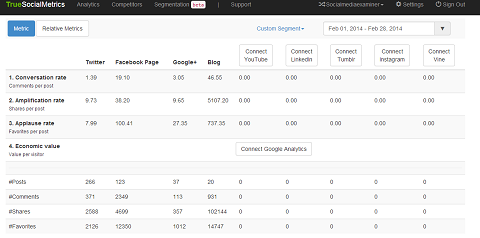
Here's what each metric means:
- Conversation rate—How many conversations does each post generate? This may include comments on Facebook and Google+ and replies to a tweet.
- Amplification rate—How often is the content reshared or retweeted?
- Applause rate—How many people like each post? On Twitter it's favorites, on Facebook it's likes and on Google+ it's the +1.
The next step is to export all of the charts and aggregate the data into a single spreadsheet. Unfortunately there's no automatic way to do this, so you'll have to enter it manually.
By looking at the data in your spreadsheet, you can use a variety of metrics to evaluate the social media performance of your site and compare it with your competitors'.
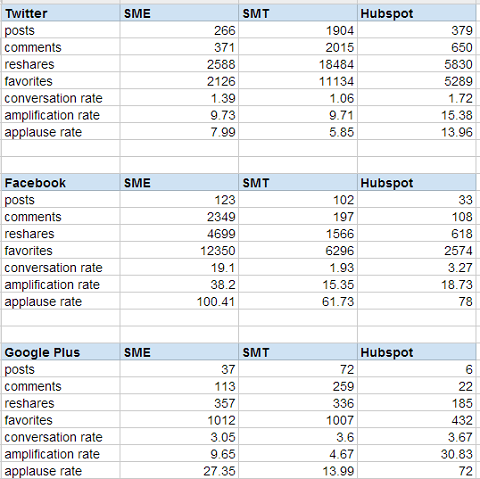
In the example above, you can see that although Social Media Today posts four times more often than HubSpot and Social Media Examiner on Twitter, their conversation, amplification and applause rates are lower. When it comes to Twitter, the competitor to watch is HubSpot.
On Facebook, the Social Media Examiner page is by far the leader. It has at least 10 times more comments than the other pages, and higher numbers in all aspects.
Google+
The conversation rate on Google+ is the same across all three competitors, yet HubSpot is vastly superior in terms of amplification and applause rates.
#3: Find the Most Successful Content Shared Across Social Profiles
Next, you can do a deep dive into each social profile to identify the most successful content on each one.
- Click on Analytics at the top.
- Select your social profile on the top left.
- Sort descending by comments, shares and favorites.
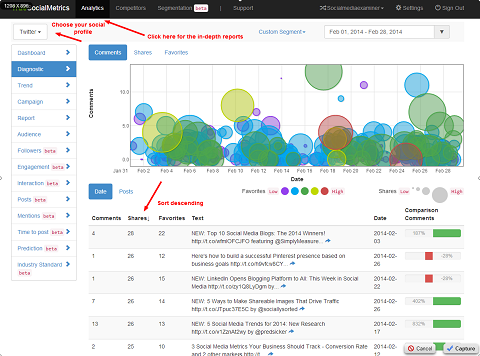
Look at the data to get a sense of what strikes a chord with followers, resulting in more engagement. Use what you find to inform your content creation strategy for both your blog and social posts.
On Social Media Examiner's Facebook page, the most shared post is very surprising.
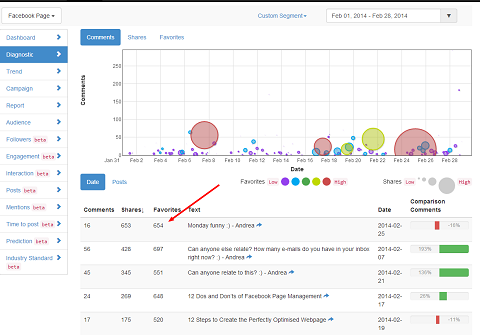
So now we know that this audience loves tech humor!

Discover Proven Marketing Strategies and Tips
Want to go even deeper with your marketing? Check out the Social Media Marketing Podcast! Publishing weekly since 2012, the Social Media Marketing Podcast helps you navigate the constantly changing marketing jungle, with expert interviews from marketing pros.
But don’t let the name fool you. This show is about a lot more than just social media marketing. With over 600 episodes and millions of downloads each year, this show has been a trusted source for marketers for well over a decade.
On Social Media Examiner's Facebook page, the most shared post is very surprising.

For Google+, HubSpot's most popular post for the month of February is an infographic about Google's algorithm changes.
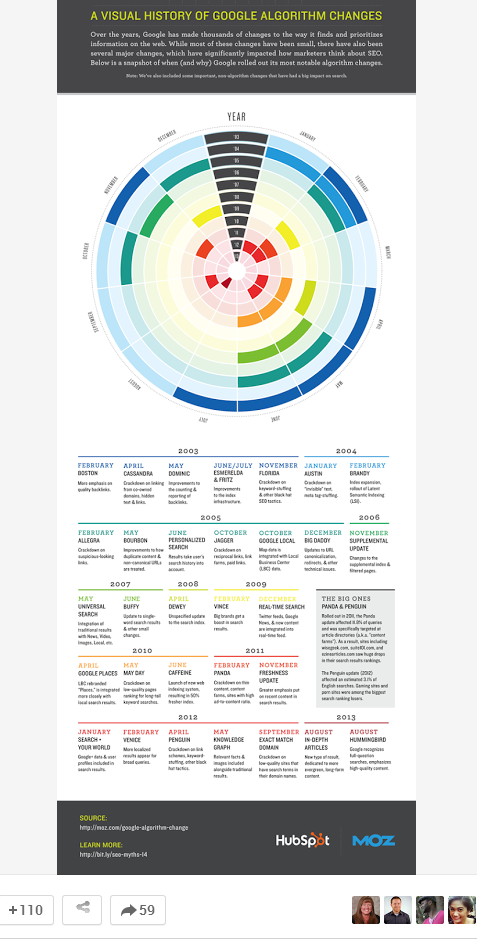
When creating a Google+ content strategy, this shows you should consider allocating resources to creating visual content and infographics.
#4: Analyze Audience Engagement
Next, let's look at the audience analysis for each of the social profiles.
Let's start with HubSpot's Google+ profile, since we know it's the most successful. In this report, you can see the most engaged members of HubSpot's Google+ audience.
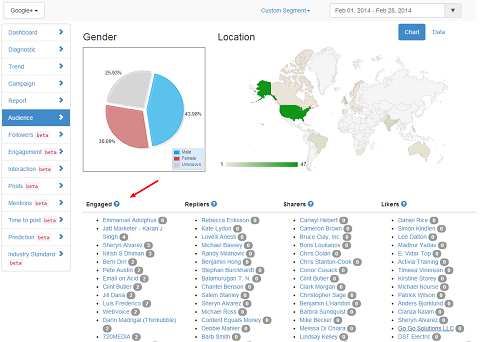
When creating an engagement strategy for your social profiles, this list can give you some people to add to your Google+ circles. Watch and interact with their content so you can lure them over to your own social profiles.
In addition, keep an eye out for your own most engaged audience members. Remember to thank them and share their content, too.
#5: Discover the Most Shared Blog Content
You can also analyze the success of blog content.
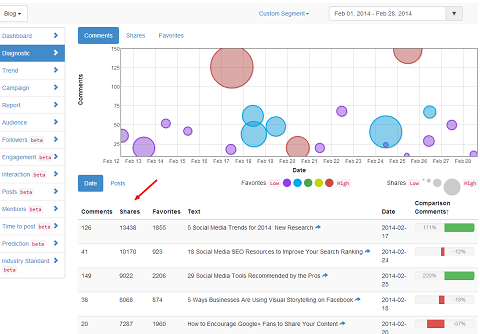
From this list, we can see that Social Media Examiner's audience is highly interested in comprehensive research and overall, big-picture trends.
Another interesting finding is that although their niche targets social media, a post about SEO had high engagement, indicating that their audience is interested in both social AND search.
Finally, one of the most popular posts is about social media tools. It has the highest number of favorites.
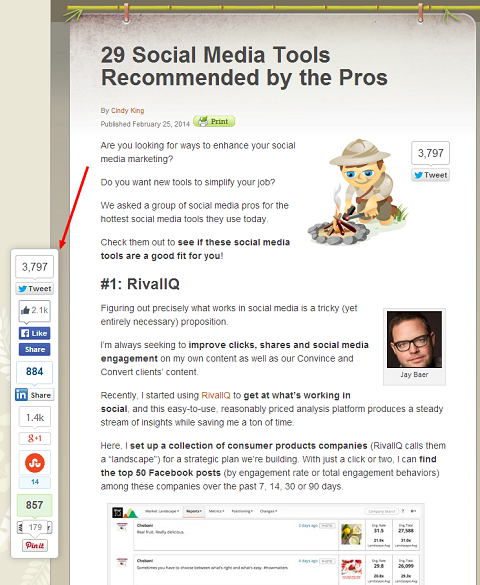
If you do an ascending sort, you can see which posts had the least amount of shares and engagement. This helps you identify topics that people aren't interested in, as well as guest writers who bring the least amount of engagement.
#6: Research Competitor Strategy
Don't limit your audit to data gathered from TrueSocialMetrics. Make an in-person visit to all of your competitors' profiles to note the overall strategy behind their social content.
Look into things like ratios of original to curated content, entertainment to industry-specific content and the most shared content.
#7: Perform Opportunity and Gap Analysis
After you've analyzed the social profiles of competitors, you can aggregate all of the information into an opportunity and gap analysis report.

Detail what your competitors are doing right and where they're failing, which will reveal your biggest area of opportunity.
Here are a few takeaways to apply from the analysis we ran for this article.
- HubSpot shows a lot of engagement on Twitter, including lots of retweets and conversations. Social Media Examiner could improve its performance on Twitter by increasing audience engagement.
- Share humorous cartoons on Twitter, Google+ and Facebook. Three of the most popular posts across the competing sites are humorous cartoons.
- Write and share more research and case studies on the blog.
- Continue sharing content about SEO across social profiles.
#8: Create Your Social Media Marketing Strategy
With the data you've discovered, you're now ready to create your own social marketing strategy!

Now that you know what content is most and least successful across social channels, incorporate this into your content creation strategy. In addition, set target goals based on the benchmarks established by your competitive research.
In Conclusion
When you invest time into a comprehensive social media audit, your findings will provide a strong foundation for your social strategy.
After you put your strategy into motion, remember to regularly audit your site and your competitors' in order to modify your strategy. Use what you learn to further capitalize on what works and improve your own weaknesses.
What are some other tools you've used for social media audits? What other information can be used from social audits to inform your social media strategy? Share your thoughts and comments below.
Images from iStockPhoto.
Attention Agency Owners, Brand Marketers, and Consultants

Introducing the Marketing Agency Show–our newest podcast designed to explore the struggles of agency marketers.
Join show host and agency owner, Brooke Sellas, as she interviews agency marketers and digs deep into their biggest challenges. Explore topics like navigating rough economic times, leveraging AI, service diversification, client acquisition, and much more.
Just pull up your favorite podcast app, search for Marketing Agency Show and start listening. Or click the button below for more information.

